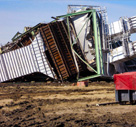
It took nearly two years to build and only seconds to come down.
On Saturday, Jan. 22, crews imploded Luminant’s old River Crest Power Plant boiler – the final major step in demolishing the retired natural gas-fueled power plant.
“It served the needs of the residents here in northeast Texas for many, many years,” said Scott Diermann, director of gas plant operations for Luminant. “As we’ve added newer, more efficient capacity, this unit became less and less economical to run.”
After 50 years of operation, the plant was retired and plans ultimately made to dismantle it. Two months leading up to the implosion, crews worked to break down River Crest piece by piece, with the final two weeks devoted to setting up for the last step of the demolition.
“We have five cuts to each one of the legs (of the boiler) and then five other charges that kick those legs out from under,” explained Eddie Siebert, vice president of Plant Recovery Company.
“You’ll hear an initial pop, that’s called lighting up the detonators,” added Eric Kelly, vice president of Advanced Explosives Demolition. “A few seconds later, the structure hits the ground.”
The high noon implosion drew a crowd of several local residents, including Burl Moore, a former River Crest employee.
“I watched it go up and now today I’m watching it come down,” laughed Moore. “This was a landmark for the whole community and it’ll be missed.”
River Crest’s story doesn’t end with its implosion, though. Ninety-five percent of the plant’s materials will be recycled, giving the plant a second life at a new facility.
“For the most part, it’ll be steel and other metals going all over the world, wherever manufacturing needs the metals,” said Diermann.
“Any equipment that’s still useable or reusable, we’re selling that, hopefully for the use that it was intended for when it was built,” added Siebert.
An environmentally friendly move that makes River Crest’s “ending” much more of a beginning.
Did you know? River Crest Power Plant came online in 1954. The single-unit plant had a capacity of 110 MW, enough to power roughly 55,000 homes year round, which it did until the plant was retired 50 years later in 2004.
